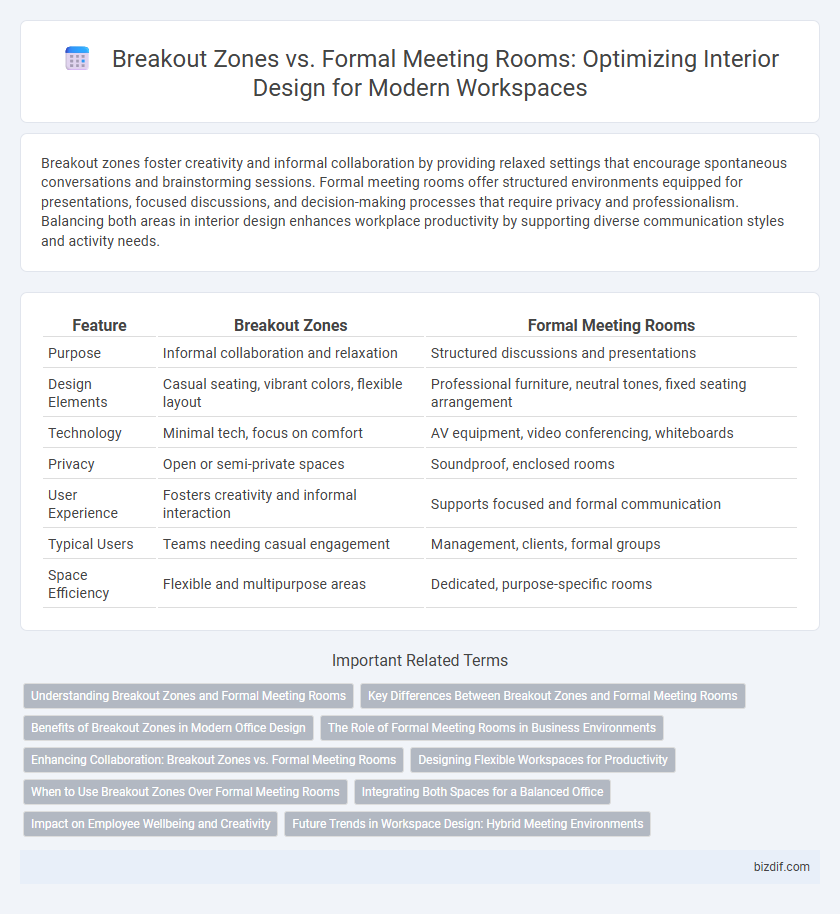Breakout zones foster creativity and informal collaboration by providing relaxed settings that encourage spontaneous conversations and brainstorming sessions. Formal meeting rooms offer structured environments equipped for presentations, focused discussions, and decision-making processes that require privacy and professionalism. Balancing both areas in interior design enhances workplace productivity by supporting diverse communication styles and activity needs.
Table of Comparison
| Feature | Breakout Zones | Formal Meeting Rooms |
|---|---|---|
| Purpose | Informal collaboration and relaxation | Structured discussions and presentations |
| Design Elements | Casual seating, vibrant colors, flexible layout | Professional furniture, neutral tones, fixed seating arrangement |
| Technology | Minimal tech, focus on comfort | AV equipment, video conferencing, whiteboards |
| Privacy | Open or semi-private spaces | Soundproof, enclosed rooms |
| User Experience | Fosters creativity and informal interaction | Supports focused and formal communication |
| Typical Users | Teams needing casual engagement | Management, clients, formal groups |
| Space Efficiency | Flexible and multipurpose areas | Dedicated, purpose-specific rooms |
Understanding Breakout Zones and Formal Meeting Rooms
Breakout zones offer informal, flexible spaces designed to foster creativity and spontaneous collaboration, often featuring comfortable seating and open layouts. Formal meeting rooms are structured environments equipped with presentation technology and conference tables, optimized for focused discussions and decision-making processes. Understanding the distinct purposes of breakout zones versus formal meeting rooms helps interior designers create balanced office layouts that support both dynamic teamwork and structured meetings.
Key Differences Between Breakout Zones and Formal Meeting Rooms
Breakout zones emphasize informal, flexible spaces designed for collaboration, creativity, and relaxation, often incorporating comfortable seating and adaptable layouts. Formal meeting rooms prioritize structured environments with conference tables, audiovisual equipment, and controlled acoustics for focused discussions and presentations. The key differences lie in their purpose, design elements, and the atmosphere they foster--breakout zones encourage spontaneity, while formal meeting rooms support professionalism and formal communication.
Benefits of Breakout Zones in Modern Office Design
Breakout zones in modern office design enhance employee creativity and collaboration by providing informal, flexible spaces that encourage spontaneous interactions. These zones reduce stress and improve mental well-being by offering a relaxed environment away from the structured setting of formal meeting rooms. Incorporating breakout zones drives innovation and fosters a dynamic workplace culture, promoting productivity beyond traditional conference areas.
The Role of Formal Meeting Rooms in Business Environments
Formal meeting rooms serve as essential spaces in business environments, providing a structured setting for strategic discussions, presentations, and decision-making processes. These rooms are equipped with technology and furnishings designed to support professionalism and productivity, enhancing communication and collaboration among team members and clients. Their design emphasizes privacy and formality, distinguishing them from breakout zones, which cater to informal interactions and spontaneous brainstorming sessions.
Enhancing Collaboration: Breakout Zones vs. Formal Meeting Rooms
Breakout zones foster informal, dynamic interactions that stimulate creativity and quick decision-making, contrasting with formal meeting rooms designed for structured, agenda-driven discussions. These flexible spaces encourage spontaneous collaboration and diverse team engagement, enhancing overall productivity and innovation. Prioritizing breakout zones in office design leverages natural communication flow, complementing the focused environment of formal meetings.
Designing Flexible Workspaces for Productivity
Breakout zones enhance creativity and informal collaboration by providing relaxed, open environments that encourage spontaneous interactions. Formal meeting rooms offer structured settings equipped with technology tailored for focused discussions, presentations, and decision-making processes. Designing flexible workspaces that integrate both areas supports diverse work styles, improving overall productivity and employee engagement.
When to Use Breakout Zones Over Formal Meeting Rooms
Breakout zones are ideal for informal discussions, brainstorming sessions, and collaborative work that requires flexibility and creativity, offering a relaxed environment that encourages open communication. These spaces foster spontaneous interaction and are best used when teams need to generate ideas quickly or engage in casual problem-solving outside a structured setting. Formal meeting rooms should be reserved for presentations, client meetings, and strategic decision-making that demand privacy, structure, and professional ambiance.
Integrating Both Spaces for a Balanced Office
Integrating breakout zones and formal meeting rooms creates a balanced office environment that supports both collaborative brainstorming and structured discussions. Breakout zones encourage creativity and informal interactions, while formal meeting rooms provide privacy and professionalism for important meetings. Designing with both spaces in mind enhances overall productivity and employee engagement.
Impact on Employee Wellbeing and Creativity
Breakout zones foster informal interactions and relaxation, significantly enhancing employee wellbeing by reducing stress and encouraging spontaneous idea-sharing. Formal meeting rooms provide structured environments that support focused discussions and decision-making but may limit creative flow and increase pressure. Balancing both spaces in office design optimizes productivity, promotes mental health, and stimulates innovation by catering to diverse workstyles.
Future Trends in Workspace Design: Hybrid Meeting Environments
Breakout zones foster creativity and informal collaboration, offering flexibility in hybrid meeting environments that accommodate both in-person and remote participants. Formal meeting rooms remain essential for structured discussions and presentations, equipped with advanced audiovisual technology to support seamless virtual integration. Future workspace designs prioritize adaptable layouts that balance casual interaction spaces with dedicated areas for focused, professional communication, enhancing overall productivity.
Breakout zones vs Formal meeting rooms Infographic

 bizdif.com
bizdif.com